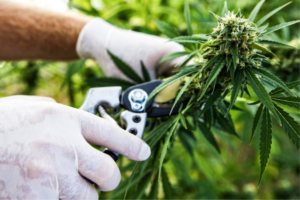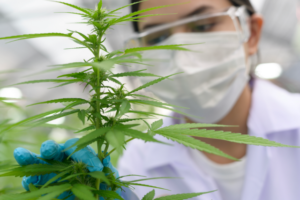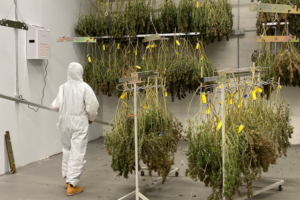Working in cannabis cultivation facilities can pose significant risks due to the physically demanding nature of the job. From everyday tasks like watering plants to harvest-related chores such as hanging plants, cultivation technicians have multiple opportunities to get injured.
Lift and Grow, experts in light-lifting and harvest technology, are well aware of the financial consequences associated with workplace injuries in commercial cannabis gardens. By developing automated machine solutions for hazardous garden tasks, Lift and Grow eliminates many of the potential hazards that can result in workplace accidents.
Common Injuries in Cannabis Cultivation Facilities
Insurance companies categorize cannabis cultivation jobs similarly to positions in traditional agriculture due to their physical demands. While the rates may vary between indoor and outdoor operations, cultivation jobs are widely recognized as some of the most dangerous in the cannabis industry.
Musculoskeletal Disorders (MSDs)
Musculoskeletal disorders (MSDs), also known as ergonomic injuries, occur when the body performs tasks using muscles, tendons, and ligaments in awkward positions or engages in repetitive activities, leading to pain and injury over time, according to the U.S. Bureau of Labor Statistics.
Indoor growers are particularly susceptible to MSD injuries. Repetitive motions like crouching to work under grow lights or squatting to water plants can have severe consequences when performed continuously on a daily basis.
Soft Tissue Injuries
Soft tissue injuries refer to damage done to muscles, ligaments, and tendons in the workplace. These injuries include common muscle sprains and severe soreness. Soft tissue injuries are often overlooked in the workplace as they are more difficult to diagnose compared to MSDs.
Employees who are forced to stretch awkwardly to complete tasks such as cleaning the bottoms of plants are at risk of soft tissue injuries.
Broken Bones & Fractures
Breaking or fracturing a bone requires a significant amount of force. When a team member experiences such a severe injury, they will need a long period of time to recover and may be unable to work.
Ladder work is one of the leading causes of broken bones and fractures on the job. Employees who climb ladders to hang plants during harvest are at risk of falling and sustaining bone injuries. In fact, ladder falls are responsible for more deaths than any other type of injury in the construction industry, according to OSHA.

Expenses Associated with Dangerous Workplaces
Employee injuries in cultivation facilities can have several negative impacts on your finances.
Workman’s Comp Expenses
No matter where your cannabis cultivation facility is located, you need workman’s comp insurance. Annual premiums for workman’s comp insurance typically range from 2% to 6% of salary expenses. If your cultivation facility has a consistently poor safety record, you can expect annual rate increases.
Injuries on the Job
If an employee is injured on the job, you are responsible for covering their wages for the entirety of their time away from work. Additionally, you must account for expenses related to training new team members and other administrative fees.
In the unfortunate event that an employee sustains a serious ladder-related injury or a similar injury, they may be unable to work for months, resulting in substantial financial costs for your business.
OSHA Certifications
Depending on the size and scope of your cannabis cultivation operation, you may need to invest in OSHA certifications for your team. The specific safety training required will vary based on the rules and regulations of your state market.
For example, Colorado requires a “General Industry 10-hour course” that covers various topics such as industrial hygiene, ergonomics, fall protection, and hazard communication. The required Colorado OSHA training for cannabis cultivation work costs $50 per employee.

How to Minimize the Risks of Working at a Dispensary
There are several steps you can take to reduce the risks faced by employees working in cannabis cultivation facilities. Not only do injuries pose significant problems for employees, but they also directly impact your business’s financial performance. Implementing measures to ensure employee safety is crucial for keeping your team motivated and minimizing financial risks.
Process Improvement
By implementing process improvement measures, you can identify potential safety hazards in your daily workflows. Start by examining common injuries such as MSDs and fractures in cannabis cultivation facilities. Then, evaluate routine tasks like watering, spraying, and facilities maintenance to identify any repetitive tasks that could result in injuries.
After identifying potential risks, implement new systems and methods that can eliminate or minimize risky behaviors.
Employee Training
Once you have assessed your workflow and developed safer methods, it is essential to train employees on workplace safety. Create standard operating procedures (SOPs) that provide specific instructions on how to safely carry out garden-related tasks. Effective employee training begins with management and should be clearly communicated to all employees.
Facilities Design & Automation
Increasing the level of automation in your cultivation facility reduces the need for manual labor, thereby minimizing the risk of injuries. This is particularly relevant for high-risk tasks like ladder work.
Lift and Grow offers several technologies that can enhance your cultivation facility’s safety and productivity. Their Light Lifting system and patented H2P Drying solutions can increase yields, shorten grow time, reduce the drying cycle, and maintain or improve the quality of your plants while enhancing worker safety.

Ready to Make Improvements? Talk to Lift & Grow Today!
As the cannabis industry becomes increasingly competitive, producers understand the value of safe working environments. Unsafe conditions not only impact employee well-being but also have financial implications. Whether it is workman’s comp insurance or paid leave for injured employees, prioritizing safety directly benefits your bottom line.
Contact Lift and Grow today to discuss creating a safe work environment at your cultivation operation.



